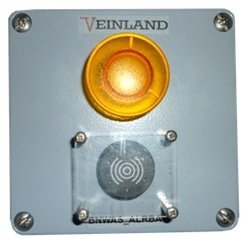
Contents
- Introduction
- Purpose of BNWAS
- Regulations and Implementation Dates
- System Components
- Control Unit
- Motion Sensors and Pressure Pads
- Alarm Units
- Timer and Reset Mechanism
- How BNWAS Works
- Case Studies: BNWAS Preventing Catastrophes
- Popular Manufacturers and Models
- Manufacturers
- Commonly Used Models
- Conclusion
- References
1. Introduction
The Bridge Navigational Watch Alarm System (BNWAS) is a critical safety device used on ships to monitor the alertness of the watch officer and ensure continuous supervision on the bridge. This system helps prevent accidents caused by the watch officer’s incapacitation due to various reasons such as fatigue or health issues.
2. Purpose of BNWAS
The primary purpose of a BNWAS is to enhance the safety of navigation by ensuring that the officer of the watch (OOW) remains alert and capable of performing their duties effectively. The system monitors the activity on the bridge and triggers alarms if no movement or input is detected within a set period, thereby alerting other crew members to potential issues.
3. Regulations and Implementation Dates
The International Maritime Organization (IMO) mandated the implementation of BNWAS under the SOLAS (Safety of Life at Sea) Convention. The timeline for implementation was as follows:
- July 1, 2011: New passenger ships and new cargo ships of 150 gross tonnage (GT) and upwards had to be fitted with BNWAS.
- July 1, 2012: Existing passenger ships and existing cargo ships of 3,000 GT and upwards had to be fitted with BNWAS.
- July 1, 2013: Existing cargo ships of 500 GT and upwards but less than 3,000 GT had to be fitted with BNWAS.
- July 1, 2014: Existing cargo ships of 150 GT and upwards but less than 500 GT had to be fitted with BNWAS.
4. System Components
Control Unit
- Main Interface: Allows the watch officer to interact with the system, set timers, and reset alarms.
Motion Sensors and Pressure Pads
- Detection Devices: Installed in the bridge area to monitor the presence and activity of the watch officer.
Alarm Units
- Visual and Audible Alarms: Located on the bridge and in selected crew areas to alert when the officer fails to reset the system.
Timer and Reset Mechanism
- Timing Device: Monitors intervals between officer activities and triggers alarms if the system is not reset within a specified period.
5. How BNWAS Works
- Activation: The BNWAS is automatically activated when the ship is underway.
- Monitoring Period: The system begins a countdown, typically set between 3 to 12 minutes.
- First Alert: If no movement or reset occurs, a visual indication is given to the watch officer.
- Second Alert: After a short delay, an audible alarm sounds on the bridge.
- Crew Notification: If there is still no response, the alarm extends to other designated crew areas.
- Escalation: Continuous lack of response triggers higher-level alarms to alert senior officers or the captain.
6. Case Studies: BNWAS Preventing Catastrophes
Case Study 1: MV Atlantic Trader
In a case reported in the North Atlantic, the cargo ship MV Atlantic Trader’s OOW became incapacitated due to sudden illness. The BNWAS detected the lack of movement and escalated the alarm to the crew quarters. Prompt response by the crew allowed them to take control of the ship, averting a potential grounding on nearby rocky shores.
Case Study 2: MS Ocean Dream
On a Mediterranean cruise, the BNWAS system detected the absence of the OOW on the cruise ship MS Ocean Dream, who had accidentally fallen asleep. The alarm sequence activated, waking the officer and alerting additional crew members. This intervention prevented a potential collision with another vessel on a converging course.
7. Popular Manufacturers and Models
Manufacturers
- Sperry Marine: Renowned for advanced navigation systems.
- Kongsberg Maritime: Known for robust marine equipment.
- TOKYO KEIKI: Provides high-quality BNWAS systems.
- Martek Marine: Offers reliable and user-friendly BNWAS solutions.
Commonly Used Models
- Sperry Marine Naviknot: A widely used model known for its reliability and integration capabilities.
- Kongsberg Maritime K-BRIDGE BNWAS: Known for its user-friendly interface and comprehensive monitoring features.
- TOKYO KEIKI BNWAS MK2: Recognized for its robust performance and compliance with international standards.
- Martek Marine Navgard BNWAS: Popular for its ease of installation and effective alarm system.
8. Conclusion
The BNWAS is an essential safety tool in the maritime industry, designed to ensure the continuous alertness of the watch officer and prevent accidents caused by incapacitation. Compliance with international regulations and proper maintenance of BNWAS can significantly enhance the safety of navigation on both commercial and passenger vessels.
9. References
- International Maritime Organization (IMO). (2010). SOLAS Consolidated Edition.
- Sperry Marine. (2021). Naviknot BNWAS.
- Kongsberg Maritime. (2021). K-BRIDGE BNWAS.
- TOKYO KEIKI. (2022). BNWAS MK2.
- Martek Marine. (2021). Navgard BNWAS.
This detailed guide provides a comprehensive overview of BNWAS, including its purpose, components, regulations, and real-world applications, to ensure the safety of maritime operations.




